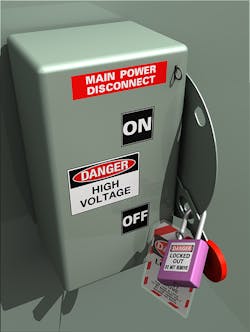Maintenance workers rely on clear and trustworthy lockout/tagout procedures to ensure that a machine will not activate during servicing. Lockout/tagout must comply with Occupational Safety and Health Administration (OSHA) standards and account for any possible changes in factory conditions. A lock or tag on a machine indicates that all energy sources are disabled and will not cause heavy parts to start moving while a person is inside. Energy sources may be hydraulic, pneumatic, electrical, or mechanical.
Any source could be locked out with an energy-isolating device that prevents the transmission of energy, such as a circuit breaker or disconnect switch. A lockout device may use a lock, blank flanges, or bolted slip blind to hold an energy-isolating device in a safe position. A tagout device, on the other hand, indicates that an energy-isolation device is ready for servicing, and should not be present if the machinery is not safe.
To help streamline this space, Master Lock Company formed a partnership with IBT Industrial Solutions to provide professional lockout services, including lockout program development, written lockout procedures, compliance training, inspections, and audits. The two companies also offer lockout products, tagout products, and OSHA lockout/tagout consulting services.
Below are six reasons why it’s a good idea to implement a trustworthy lockout/tagout system in your factory:
- Federal law and OSHA require a lockout/tagout procedure for all equipment energy sources. Todd Grover, the Global Senior Manager of Applied Safety Solutions at Master Lock, suggests that factory owners hire a professional to implement a lockout/tagout (LOTO) program in their facilities to ensure complete coverage and avoid any possible accidents. If self-implementing a program, facility owners should review OSHA standard 29 CFR 1910.147, which covers the control of hazardous energy, and CFR 1910.212, which explains general guarding requirements for all machines. ANSI standards Z244.1 and B.11 explain how to implement LOTO and machine guarding.
- Lockout incidents can happen at any time. According to Grover, “The #1 risk to your organization is complacency, especially if you have a history of no accidents. Lockout accidents are very random. People are usually surprised when they happen. This could be the 100th time your employee has performed this routine maintenance task—when suddenly, a change in circumstances allows an accident to happen.”
- Injuries and accidents can be severe, from crushing to electrocution. Energy sources can unexpectedly activate if they’re not in a secure “off” position, harming everyone in the repair or maintenance activity.
- Factory owners may not realize that their lockout/tagout programs are lacking. “80% of all companies have inadequate lockout/tagout programs,” said Grover, judging from his experience at Master Lock. “Approximately 50% have a partial program, and an estimated 30% have absolutely no program in place whatsoever.”
- A company must self-report machine-related injuries and fatalities to OSHA, according to a new requirement released in January 2015. An accident, injury, or fatality triggers in-depth investigation of the entire operation. Injuries resulting from non-compliance with OSHA standards will incur several citations.
- It is easy to start a lockout/tagout program. When setting up a program with Master Lock, a certified lockout practitioner tours the factory floor, identifies all energy sources, and devises optimal LOTO procedures for the equipment and factory conditions. The practitioner comprises a blueprint based on OSHA standards, and trains employees in new practices. Master Lock continues to work with the company, modifying the LOTO procedure as the company makes changes in machinery or policy.
Source: Industrial Solutions PrimeMover Enewsletter


